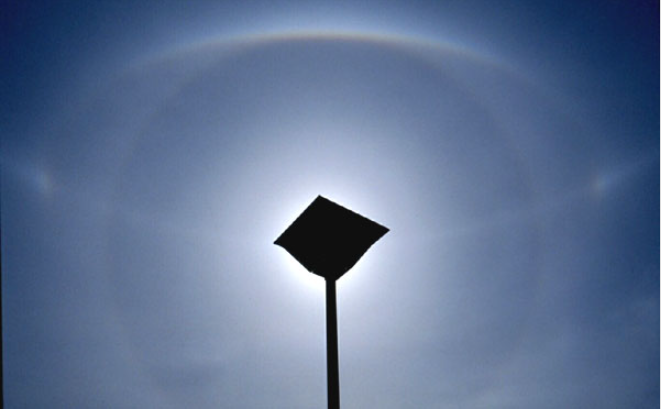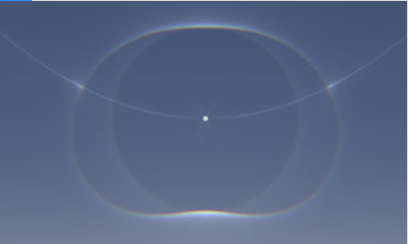Circumscribed Halo
Circumscribed Halo: A Fascinating Atmospheric Phenomenon
The circumscribed halo is a captivating atmospheric optical phenomenon that occurs when sunlight interacts with ice crystals in the atmosphere. It is a rare occurrence that is often observed in polar regions, where the conditions for ice crystal formation are favorable. In this article, we will delve into the intricacies of the circumscribed halo and explore its formation, characteristics, and accompanying phenomena.
Formation of the Circumscribed Halo
The circumscribed halo is formed when sunlight passes through hexagonal ice crystals in the atmosphere. These ice crystals act as prisms, bending and refracting the light as it passes through them. The specific geometry of the ice crystals plays a crucial role in determining the appearance of the halo.
Characteristics of the Circumscribed Halo
The circumscribed halo appears as a bright ring around the sun, typically located at a distance of approximately 46 degrees from the solar disk. It intersects with other atmospheric optical phenomena, such as the 22-degree halo and the parhelic circle. The upper and lower sections of the circumscribed halo are particularly bright when the sun is at a low altitude, below 50 degrees.
Accompanying Phenomena: The Parhelic Circle
A fascinating aspect of the circumscribed halo is its association with the parhelic circle. The parhelic circle is a ring of light that runs parallel to the horizon and passes through the sun and its reflection point. It is primarily formed by the same horizontal column crystals that give rise to the circumscribed halo. When a high sun circumscribed halo is observed, it is often accompanied by a bright parhelic circle.
Observations and Photography
Capturing the beauty of a circumscribed halo can be a rewarding experience for photographers and skywatchers alike. The halo presents itself as a mesmerizing ring of light encircling the sun, creating a striking visual display. To photograph a circumscribed halo, one must be in the right place at the right time, with favorable atmospheric conditions and an unobstructed view of the sky.
The Role of Solar Altitude
The altitude of the sun plays a crucial role in the appearance of the circumscribed halo. At solar altitudes below 50 degrees, the upper and lower sections of the halo are particularly bright. As the sun rises higher in the sky, the brightness of the circumscribed halo diminishes, and it becomes less prominent. This change in appearance is attributed to the varying angles at which sunlight interacts with the ice crystals.
Geographic Distribution
The circumscribed halo is more commonly observed in polar regions, where the conditions for ice crystal formation are more favorable. However, it can also occur in other parts of the world, albeit less frequently. The geographic distribution of the circumscribed halo is influenced by factors such as temperature, humidity, and atmospheric stability.
Unveiling the Mysteries
While scientists have made significant progress in understanding the formation and characteristics of the circumscribed halo, there are still many mysteries surrounding this fascinating atmospheric phenomenon. Ongoing research and advancements in atmospheric optics continue to shed light on the intricacies of the halo and its interactions with other optical phenomena.
Appreciating Nature's Spectacle
Witnessing a circumscribed halo is a reminder of the awe-inspiring beauty and complexity of our natural world. It serves as a testament to the harmonious interplay between light, ice crystals, and atmospheric conditions. By taking a moment to appreciate these rare occurrences, we gain a deeper understanding of the intricate wonders that surround us.
Conclusion
The circumscribed halo is a captivating atmospheric phenomenon that showcases nature's artistry and scientific principles. Its formation, characteristics, and accompanying phenomena make it a topic of fascination for scientists and sky enthusiasts alike. As we continue to explore the mysteries of the circumscribed halo, we gain a greater appreciation for the wonders that unfold in the skies above us.

Circumscribed Halo around a 43º high sun. Aurora photographer Tom Eklund (aurorae, halos and other images) captured this bright display in Finland on 11th May '02. The upper part of the circumscribed halo is visible, curving downwards over the fainter 22º halo and intercepting the parhelic circle at the sundogs. Incidentally, notice how at this solar altitude the sundogs no longer touch the 22º halo.

The matching HaloSim simulation shows the complete circumscribed halo. At solar altitudes below 50º only the upper and lower sections are particularly bright.
The bright parhelic circle was mostly formed by the same horizontal column crystals which formed the circumscribed halo. High sun circumscribed halos are often accompanied by a parhelic circle.
Note: this article has been automatically converted from the old site and may not appear as intended. You can find the original article here.
Reference Atmospheric Optics
If you use any of the definitions, information, or data presented on Atmospheric Optics, please copy the link or reference below to properly credit us as the reference source. Thank you!
-
<a href="https://atoptics.co.uk/blog/circumscribed-halo-4/">Circumscribed Halo</a>
-
"Circumscribed Halo". Atmospheric Optics. Accessed on April 19, 2024. https://atoptics.co.uk/blog/circumscribed-halo-4/.
-
"Circumscribed Halo". Atmospheric Optics, https://atoptics.co.uk/blog/circumscribed-halo-4/. Accessed 19 April, 2024
-
Circumscribed Halo. Atmospheric Optics. Retrieved from https://atoptics.co.uk/blog/circumscribed-halo-4/.